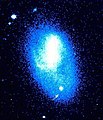NGC 1536
| NGC 1536 | |
|---|---|
 A Legacy Survey DR10 image of NGC 1536 | |
| Observation data (J2000 epoch) | |
| Constellation | Reticulum |
| Right ascension | 04h 11m 00.90s[1] |
| Declination | −56° 29′ 13.0″[1] |
| Redshift | 0.004059 ± 4.30e-5[1] |
| Distance | 57 Mly (17.71 Mpc)[1] |
| Apparent magnitude (V) | 12.5[2] |
| Characteristics | |
| Type | SB(s)c pec?[1] |
| Size | 42,000 ly[1] |
| Apparent size (V) | 1.905′ × 1.259′[2] |
| Notable features | N/A |
| Other designations | |
| ESO 157-IG 005,[1] ESO 040957-5636.9,[1] AM 0409-563,[1] WISEA J041059.94-562850.6[1] | |
NGC 1536 is a peculiar barred spiral galaxy located around 57 million light-years away in the constellation Reticulum.[1][2][3] It was discovered on December 4th, 1834 by the English astronomer John Herschel, and it has a diameter around 42,000 light-years.[1][2][4] NGC 1536 is not known to have much star-formation, and it is not known to have an active galactic nucleus.[1][2]
SN 1997D
SN 1997D is a Type II Supernova in NGC 1536 discovered by Duília de Mello in 1997. SN 1997D had a low expansion velocity, and it is believed that the explosion produced a stellar mass black hole, instead of a neutron star. SN 1997D was located in the southernmost part of NGC 1536.[5]
Gallery
- SN 1997D is visible in the southern part of NGC 1536 in the image above
- A Digitized Sky Survey (DSS) image of NGC 1536
References
- ^ a b c d e f g h i j k l m "By Name | NASA/IPAC Extragalactic Database". ned.ipac.caltech.edu. Retrieved 2025-01-05.
- ^ a b c d e "New General Catalog Objects: NGC 1500 - 1549". cseligman.com. Retrieved 2025-01-05.
- ^ "NGC 1536 - Galaxy in Reticulum | TheSkyLive.com". theskylive.com. Retrieved 2025-01-05.
- ^ "NGC 1536 - Galaxy - WIKISKY". wikisky.org. Retrieved 2025-01-05.
- ^ Benetti, S.; Turatto, M.; Balberg, S.; Zampieri, L.; Shapiro, S. L.; Cappellaro, E.; Nomoto, K.; Nakamura, T.; Mazzali, P. A.; Patat, F. (2001-04-01). "The fading of supernova 1997D". Monthly Notices of the Royal Astronomical Society. 322: 361–368. doi:10.1046/j.1365-8711.2001.04122.x. ISSN 0035-8711.
External links
 Media related to NGC 1536 at Wikimedia Commons
Media related to NGC 1536 at Wikimedia Commons- https://ui.adsabs.harvard.edu/abs/1998ApJ...498L.129T/abstract
- https://iopscience.iop.org/article/10.1086/311324/fulltext/


